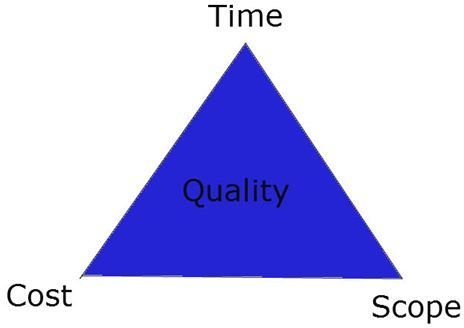Explaining the Triple Constraint Project Paradigm
The Basics
The Triple Constraint is useful as a straightforward way to talk about the limits and demands of a project. You are probablly familiar with the old adage often posted on the walls of plumbing and electrical shops: “You can have it quick, cheap, or good. Pick any two”. In today’s lingo, this has been translated into the three-point triangle of the Triple Constraint:
- Time
- Cost
- Scope
The idea remains the same: although the limits of an overall result may be flexible, unless a project manager is able to work some kind of magic, a change in one of these elements will produce a change in another.
You Get What You Pay For
Regarding the Cost principle: the cheaper your cost, the less quality you will get. For example, when labor is rushed to make up for a lower project budget, or when a project can be completed more quickly for a higher cost, we call Time vs. Cost. Other changes in cost effect the project’s scope in various ways. Factors in Cost include materials, labor rates (which can change based on the time principle), and other aspects like risk management. Project managers try their best to identify cost components and communicate them to the client to get a better result. Some called “client education”: it helps streamline the understanding of what the result will be, and helps avoid critical problems in a project’s ’endgame’, when a client might have complaints about cost factors that weren’t made clear earlier.
A Scope Example: Project Inflation
Scope is a critical factor in a project that always effects other variables. The less a contractor has to do, the quicker it can be done, and the lower the cost will be. This is pretty straightforward, but many times, Scope problems (some caused, again, by insufficient communication) threaten to make a project collapse.
Project Inflation happens when a client wants to increase the scope of a project without changing the cost or time. Imagine the individual workers in a company providing a service, for example, widgets. The client calls and asks for many more features on the widgets, without expanding the project budget or providing more time. This throws the provider into a tailspin as managers struggle to “make it fit”. Here is where communicating the Triple Constraint can save everyone a lot of headache. In some cases, the client is unaware of the problems they are causing, but in other cases, the client may be deliberately squeezing a service provider to test their limits. In either case, someone should let the client know that Scope can be changed only with resulting changes to Time and/or Cost.
Your Toolbox
There are many scenarios where project managers will encounter the Triple Constraint, keeping this principle in mind will help a manager:
- Know when to approach the subject
- What to say about it when balancing a client’s demands
- What is feasible in-house
That’s why the time-tested truism is popular with managers everywhere.
